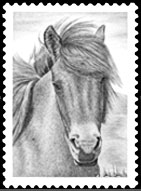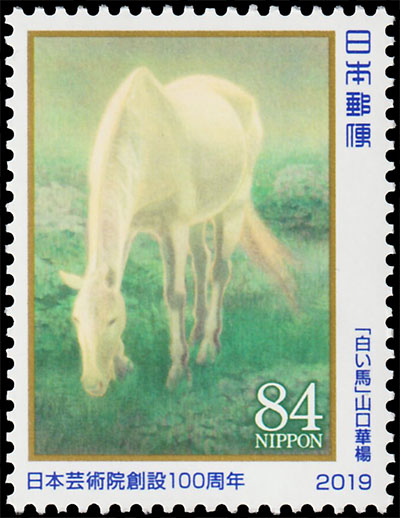
The Japan Art Academy is a cultural and academic institution and has the status of a special organization in the Department of Culture of the Ministry of Education, Culture, Sports, Science and Technology of Japan. The history of the academy is formally led to the formation of the Art Committee (Bijutsu Shinsa Inkai) at the beginning of the 20th century (Meiji period) at the Ministry of Culture of Japan to develop high-quality standards of fine arts and organize art exhibitions. In September 1919, the Art Committee was renamed the Imperial Academy of Arts, for the first time gaining academic status. The Japan Art Academy coordinates and supports the development of the arts in Japan through an annual award in five categories (visual arts, music, literature, dance and performing arts).
In honor of the Academy’s 100th anniversary, Japan Post released a miniature sheet of 10 stamps depicting works by famous Japanese artists of different years.
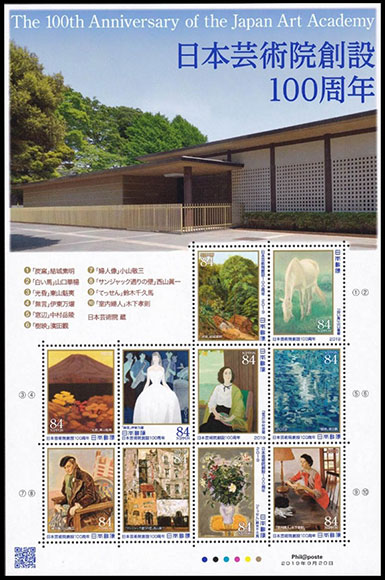
"Charcoal Kiln" (1934), Yūki Somei (1875-1957), "White Horse" (1952), Yamaguchi Kayō (1899-1984), "Evening Glow" (1955), Higashiyama Kaii (1908-1999), "Silence", Man'yō Itō (1921-1970), "By the Window", Nakamura Gakuryo (1890-1969), "Reflected Trees", Hamada Kan (1898-1985), "Portrait of a Woman", Koyama Keizō (1897-1987), "Wall of San Jacques Street", Nishiyama Shin'ichi (1906-1989), "Clematis", Chikuma Suzuki (1894-1980) and "Indoor Woman" (c. 1956), Kinoshita Takanori (1873-1973).
Stamps issued in a miniature sheet, at the top of the sheet is the building of the Japan Art Academy in Tokyo.
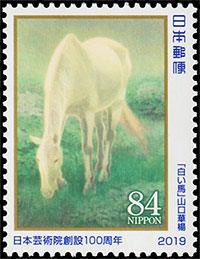
On the second stamp of the series, the painting "White Horse" by Japanese artist Kayo Yamaguchi, painted by him in 1952, is reproduced.
A white horse with closed eyes grazes in a meadow with lush green grass. The snow-white skin of the horse literally glows, giving the impression of a certain illusory nature. It seems worth averting your eyes and the horse will melt like a fantastic vision. All the works of Kayo Yamaguchi, a Japanese animal painter, are full of power and charm, they are realistically designed, but very delicate.
Kayo Yamaguchi was born in Kyoto in 1899. From childhood, he was immersed in the artistic universe: his father was a craftsman engaged in dyeing fabrics. The latter himself wanted to become an artist, but circumstances prevented this, and it was his son who fulfilled the dream of his old father. As a child, Kayo's parents often took him to the zoo. The boy constantly painted animals or sculpted from clay. Kayo was barely 11 years old when he was admitted to the workshop of Nishimura Gone, one of the teachers of the Kyoto school. According to established practice, the young man began by copying the models presented to him by the master, then he learned the art of drawing from nature. In 1916, Kayo continued his studies at the Municipal School of Painting in Kyoto under the direction of Takeuchi Seyho.
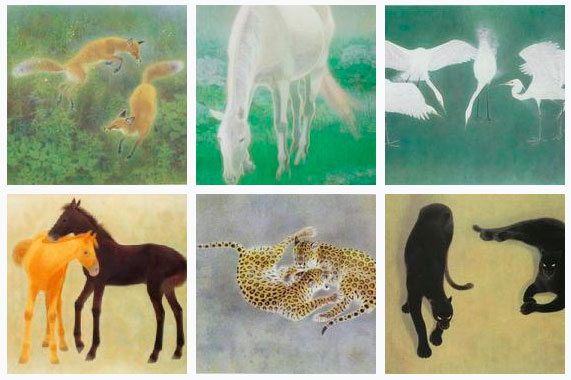
Kayo Yamaguchi is fully focused on the image of animals, working in the Nihong style watercolor technique. Animalistic traditions in Japanese painting have deep roots, but such a focus on one genre is rare. After graduation, Kayo Yamaguchi successfully participated in national exhibitions, as well as in graphic research groups. After the 1930s, his paintings were repeatedly exhibited at national exhibitions in Japan and international exhibitions in Europe. In 1956, Yamaguchi was awarded the prize of the Academy of Arts of Japan, and in 1971 he became a member of the Academy, in 1981 he was awarded the Order of Culture. The artist died in 1984. Several of his works are kept at the Japan Academy of Arts in Tokyo.
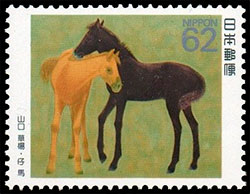 By the way, “White Horse” is not the artist’s first work on a postage stamp. In 1990, in the Horses series, a stamp was released depicting Kayo Yamaguchi's Foals, painted by the artist in 1955.
By the way, “White Horse” is not the artist’s first work on a postage stamp. In 1990, in the Horses series, a stamp was released depicting Kayo Yamaguchi's Foals, painted by the artist in 1955.Перейти в каталог
